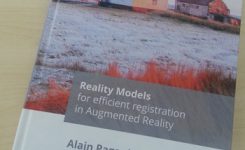
Alain Pagani hat am 13.06.2014 seine Dissertation mit der wissenschaftlichen Aussprache erfolgreich abgeschlossen.
Seine Doktorarbeit trägt den Titel „Reality models for efficient registration in Augmented Reality“. In seiner Arbeit befasste sich Alain Pagani mit mathematischen Modellen realer Objekte oder Szenen, um das Problem der Kameraregistrierung im Forschungsfeld Erweiterte Realität zu behandeln. Die vorgeschlagenen bildbasierte Verfahren ermöglichen eine effiziente Kamerapose-Berechnung in unterschiedlichen Szenarien und lösen somit eine grundliegende Herausforderung der erweiterten Realität.
Gutachter der Arbeit sind Prof. Dr. Didier Stricker und Prof. Dr. Michael Felsberg (Linköping University).
Wir gratulieren Alain Pagani herzlich zu diesem Erfolg!










